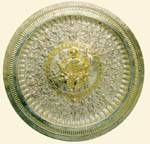|
|
| Byzantine Minor Arts |
1622, Indiction V Protaton Silver, parcel-gilt Diameter 45 cm |
|

|
The relief image on the central boss is of St Nicholas, seated on a cushion on a high-backed throne, feet resting on a foot-stool, right hand raised in blessing, left hand holding up a closed Gospel. Above him, on either side, are miniature busts of Christ and the Virgin, offering the saint a book (Gospel) and an omophorion, the symbols of the episcopal office he had lost, when during the first Ecumenical Council of Nicaea he cuffed the heretic Arius. On the left is a miniature portrait of Pantazis, the donor, represented on his knees offering his gift to the saint: normally, he should be pictured at the saint's feet, but this would have been impossible in the space available. The boss is framed by a border in the Renaissance style. All around this central boss, and aligned with the focal figure of St Nicholas, scrolls a vine, developing in gentle relief the thematic motif of Christ as the True Vine and a variant of the Virgin as a Rod out of the Tree of Jesse. Broad flutes mark the rise from the flat bottom of the plate to the rim, where the pattern of flutes is repeated on a smaller scale. The elegantly designed inscription facing outwards and running around the outer edge of the rim reads as follows: '+ Ο ΠΑΡΩΝ ΔΙΣΚΟΣ ΕΓΕΝΕΤΩ. ΔΙΑ ΣΥΝΔΡΟΜΗΣ ΚΑΙ ΔΑΠΑΝΗΣ ΤΟΥ ΤΙΜΙΩΤΑΤΟΥ ΚΥΡΟΥ ΠΑΝΤΑΖΗ. ΥΙΟΥ ΑΚΑΚΙΟΥ ΜΟΝΑΧΟΥ. ΚΑΙ Μ(ΗΤ)Ρ(ΟΣ) Α(ΥΤΟ)Υ ΘΕΟΔΩΡΑΣ. ΚΑΙ ΑΦΙΕΡΩΘΗ ΤΗ ΕΚΚΛΗΣΙΑ ΤΟΥ ΑΓΙΟΥ ΝΙΚΟΛΑΟΥ ΤΟΥ ΘΑΥΜΑΤΟΥΡΓΟΥ. ΕΝ ΤΩ ΚΟΝΤΟΣΚΑΛΙΩ ΕΤΙ αχκβ( ινδ ε( ΤΕΧΝΗ ΚΩΝΣΤ(ΑΝ)ΤΗΝΟΥ (ή ΚΩΝΣΤΑΝΤΙΟΥ;) ΣΤ... (;) ΑΠΟ ΝΑ...ΙΟΥ' (This paten was commissioned by the venerable Pantazis, son of Akakios, the monk, and his mother Theodora and given to the Church of St Nicholas the Miracle-worker in Kontoskali in the year 1622, fifth indiction. By the artist Const(an)tine (or Constantius?) St... (?) of Na...ios). Initially dedicated to a church honouring St Nicholas, this paten displays as its central theme a portrait of the saint in the traditional type of Cretan painting (Vassilaki 1994, pp. 242-3, figs. 2-4). Christ as the True Vine (John 15: 1-2) appears to have been introduced to iconography by fifteenth-century Cretan painters (Eikones 1993, no. 119, pp. 475-6). On this paten, Christ is portrayed full-length, seated not on a vine root but on a shoot which branches out to both sides, twining around the apostles and then around the prophets surrounding the figure of the Virgin, thus uniting the two themes. The theme of the Rod out of the Tree of Jesse is based on a prophecy in the Book of Isaiah, which is held to prefigure the Virgin and the Incarnation, and was developed as a genealogy in order to establish her as a descendant of the royal line of David (Aspra-Vardavaki 1992, pp. 36-42). In the variant used on this paten Jesse is not shown, nor is the Virgin portrayed holding Christ, who is however present - at the top of the paten - within the same axis. These two themes were frequently used together in the decoration of triptychs, vestments and wood-carved enkolpia (Muρoz 1906, p. 44, fig. 22. Theochari 1990, pp. 258-9, figs. 24-5. Radojkovic 1977, figs. 54-5). In this particular instance the theme of the Rod out of the Tree of Jesse is associated with the eucharistic character of the vessel, which was apparently originally used for the Breaking of the Bread: the points around the rim where three candles would have been fixed are still visible, although the candle-holders themselves are gone. The silversmith of this paten, whose name unfortunately remains undeciphered, has created a powerful, complex and finely crafted work of art, which a certain asymmetry in the rendering of the lower part of the saint's body does nothing to diminish. The evident influence of the Cretan School in stylistic and iconographic features reminiscent of Renaissance and Mannerist works, such as the border of the central boss and the formation of the rim, suggest that the goldsmith probably learned and/or practised his craft in Latin-occupied Greece (Koumarianou - Droulia - Layton 1986, fig. 214. Hayward 1976, fig. 80. Pazzi 1993, figs. on pp. 53 and 97). The theme of Christ as the True Vine may be seen on a stamped Gospel cover in the Church of St Basil, Corfu (Tsitsas 1994, fig. on p. 191), while the representation of the donor as a suppliant is found on a stamped paten of Cretan manufacture in the Chozobiotissa Monastery on the island of Amorgos. While the Church of St Nicholas in Kontoskali mentioned in the inscription is not listed as one of Constantinople's more important churches, at least in its more recent history, we do know that until 1683 the Feast of St Nicholas continued to be celebrated there. How it came into the possession of the Protaton is not recorded, but it continues to be used on the great feast days for the distribution of the antidoron (Gedeon 1904, pp. 130-1, 282).
| |
|
Bibliography: Millet - Pargoire - Petit 1904, no. 20, pp. 8-9.
| ||
| Y. I.-P. | ||
| Index of exhibits of Protato 17th century |
||
Reference address : https://www.elpenor.org/athos/en/e218ci66.asp